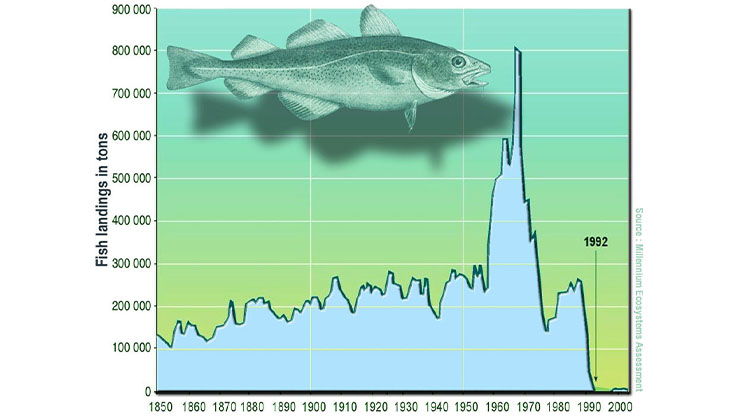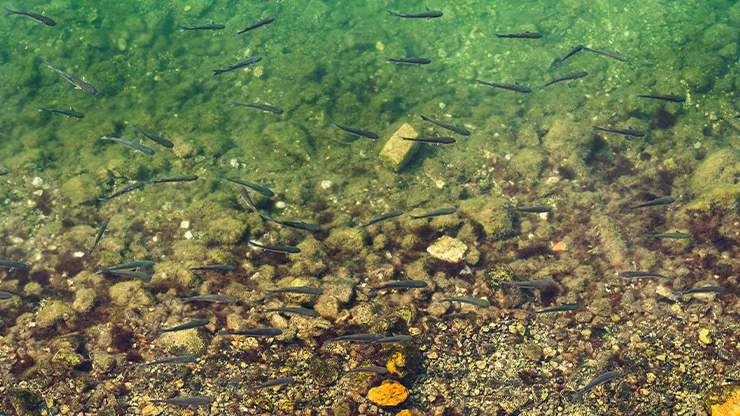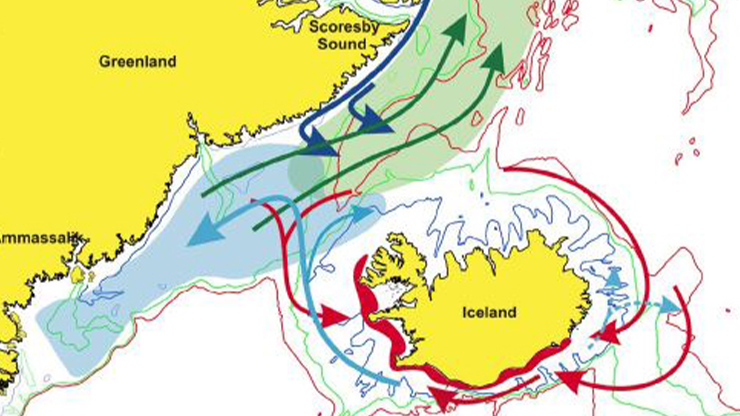Assessing Cannibalism’s Impact on the Cyclical Population Dynamics of Snow Crabs
The snow crab fishery is one of Canada’s most profitable fisheries and a significant economic driver in coastal communities (see Figure 1). Snow crabs prefer cold water and are stenothermic, meaning that they can only tolerate a narrow range of temperatures. As such, gradual warming due to climate change presents a real concern for future populations of the crustacean. In the past few years, billions of snow crabs have abruptly disappeared from the Bering Sea off the coast of Alaska due to an ecological shift in conditions [1]. While the Canadian population has not yet experienced this type of sudden collapse, local scientists wish to better understand the relevant population dynamics and prospective effects of global warming.

Interestingly, snow crabs undergo marked population fluctuations over a period of eight to 12 years. Possible causes of these fluctuations include both intrinsic (density-dependent) and extrinsic (environmental) factors. During a contributed presentation at the Third Joint SIAM/CAIMS Annual Meetings, which are currently taking place in Montréal, Québec, Canada, Sophie Léger of the Université de Moncton presented a discrete-time structured population model that examines the mechanisms behind the cyclical patterns of snow crab populations in the southern Gulf of St. Lawrence (GSL) (see Figure 2).
Léger began with some general background about the species. Snow crabs grow via successive molts—typically in the spring of each year—until growth ceases with the terminal molt. For females in the GSL, egg development usually takes two to three years. After the eggs hatch in the spring, the larvae remain in the water column for several months before settling on the gulf bottom and metamorphizing to the juvenile stage, which lasts roughly four years.
In eastern Canada, it is illegal to land female crabs. In fact, fishermen are only allowed to commercially exploit males of a certain size. An appropriate mathematical model should hence observe the aforementioned key aspects of all relevant data, including trawl survey data for the southern GSL. This data revealed that periodicities in GSL crab populations fluctuate around 7.2 and 10.8 years.
Léger’s model accounts for the three developmental stages for each gender: immature (i.e., juveniles), adolescent (prepubescent for females), and mature (i.e., adults). She assumes a 1:1 sex ratio in terms of reproduction, where half of the juveniles become males and half become females. The model is associated with six difference equations that represent (i) the probability of surviving and remaining in the same stage; (ii) the probability of surviving and progressing to the next stage; (iii) the survival probability, which includes both natural and fishing mortality; (iv) the cannibalistic mortality rate; (v) a fixed fishing mortality rate; and (vi) fixed fertility, which acknowledges that not all females produce eggs every year.
![<strong>Figure 2.</strong> Map of the Gulf of St. Lawrence in Canada. Figure courtesy of [2].](/media/ouehg3am/figure2.jpg)
Léger’s numerical results exhibit the same types of natural fluctuations that are evident in the survey data. Fluctuations in her model occur at a period of 7.7 years, which is close to the data’s 7.2 years. “Overall, we feel that the math model gives a good representation of what is observed in the survey data for this region,” Léger said.
Next, Léger sought to identify and assess the factors that drive cyclical population patterns. She was particularly interested in density-dependent factors like cannibalism, as snow crabs are known to display cannibalistic behavior. “When we add a small amount of cannibalism [to the model], the population actually stabilizes itself and natural fluctuations occur in a very small amount,” Léger said, confirming that cannibalism does contribute to the 7.7-year fluctuations.
Léger then examined the effect of a variable larval survival rate on overall population. “The larval survival rate is typically not constant over the years,” she said. “Could these fluctuations come from environmental factors?” To simulate such factors, she varied the larval survival rate in her model from 1.1 percent to 1.9 percent over a period of 10.8 years.
In the absence of cannibalism, Léger found that fluctuations of the larval survival rate lead to an abundance that increases exponentially in an oscillatory manner without ever reaching stable oscillations. Indeed, the possibility of a periodic solution only exists for one specific, unrealistic fertility value. “Without cannibalism, variations on the larval survival rate—and consequently on the fertility value—are not enough to induce cyclicity in the abundance of the population,” Léger said.
Lastly, Léger discovered that adding cyclicity to other factors—such as fishing mortality or natural mortality—yields additional periods in the periodogram in the presence of cannibalism. But without cannibalism, no stable cyclicity is present in the overall population.
The explicit incorporation of cannibalism sets Léger’s model apart from existing studies about snow crab population dynamics. “This is important because most models in the literature due not incorporate cannibalism,” she said. “From our analysis, density-dependent intercohort processes seem to be the leading factor of natural cycles in the abundance of the population.” Because the model outputs exhibit oscillations that are consistent with observed population cycles, Léger hopes that her model will help predict long-term behavior. In the future, Léger intends to explore other elements of climate change—including the prospective introduction of new predators and potential changes in food supply—and their subsequent impact on the snow crab population.
References
[1] Alaska Fisheries Science Center. (2024, August 21). Snow crab collapse due to ecological shift in the Bering Sea. National Oceanic and Atmospheric Administration. Retrieved from https://www.fisheries.noaa.gov/feature-story/snow-crab-collapse-due-ecological-shift-bering-sea.
[2] Beauchesne, D., Daigle, R.M., Vissault, S., Gravel, D., Bastien, A., Bélanger, S., … Archambault, P. (2020). Characterizing exposure to and sharing knowledge of drivers of environmental change in the St. Lawrence system in Canada. Front. Mar. Sci., 7, 383.
About the Author
Lina Sorg
Managing editor, SIAM News
Lina Sorg is the managing editor of SIAM News.

Stay Up-to-Date with Email Alerts
Sign up for our monthly newsletter and emails about other topics of your choosing.






